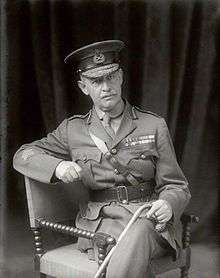Havelock Hudson
| Sir Havelock Hudson | |
|---|---|
 General Sir Havelock Hudson | |
| Born | 22 June 1862 |
| Died | 25 December 1944 (aged 82) |
| Allegiance |
|
| Years of service | 1881-1924 |
| Rank | General |
| Commands held |
8th Division Eastern Army in India |
| Battles/wars |
Boxer Rebellion World War I |
| Awards |
Knight Grand Cross of the Order of the Bath Knight Commander of the Order of the Indian Empire |
General Sir Havelock Hudson, GCB, KCIE (22 June 1862[1] – 25 December 1944[2]) was a British Indian Army officer who was General Officer Commanding 8th Division during World War I.
Military career
Hudson was commissioned into the Northamptonshire Regiment as a lieutenant on 22 October 1881.[3] He transferred to the Indian Staff Corps in 1885[4] and became an officer of the 19th Lancers from that year.[5]
Promoted to captain on 22 October 1892, he served on the staff during the North West Frontier campaign in 1897.[6] He briefly acted as deputy assistant quartermaster-general at Indian army headquarters June–August 1900,[7] then was appointed a staff officer in the China Field Force for the Boxer Rebellion later that year. In 1901 he took part in the second Miranzai expedition in 1901.[8]
He commanded the 19th Lancers from 4 February to 27 August 1910.[5]
He was appointed a General Staff Officer Grade 1 with the Directorate of Staff Duties and Military Training on 1 July 1910.[9]
He was appointed Commandant of the Cavalry School at Sangor in India 1 July until 30 September 1912 and became Brigadier-General on the General Staff of the Northern Army on 1 October 1912.[8][4]
He served in World War I as Brigadier-General on the General Staff of the Indian Corps from 1914,[10] then was appointed General Officer Commanding 8th Division on the Western Front from 31 July 1915[11] (in which capacity he led the attack on Ovillers losing 5,400 men)[10] until 8 December 1916 [4] and was appointed Adjutant General, India from 5 Feb 1917 until 30 October 1920.[8] Following the Amritsar massacre in 1919 it fell to Hudson, in his capacity as Adjutant-General, to tell Brigadier Reginald Dyer that he was relieved of his command.[12] He went on to be General Officer Commanding-in-Chief, the Eastern Army in India on 1 November 1920 [4] before retiring in 1924.[8]
In retirement he was a member of the Council of India.[8]
References
- ↑ January 1930 Indian Army List Supplement
- ↑ Officer Casualties of the Indian Armies 1803-1946 by A. J. Farrington
- ↑ "No. 25126". The London Gazette. 11 July 1882. p. 3214.
- 1 2 3 4 Quarterly Army List March 1922
- 1 2 History of the 19th King George's Own Lancers 1858-1921
- ↑ Hart′s Army list, 1901
- ↑ "No. 27469". The London Gazette. 29 August 1902. p. 5610.
- 1 2 3 4 5 Liddell Hart Centre for Military Archives
- ↑ Indian Army List April 1911
- 1 2 University of Birmingham
- ↑ Army Commands Archived 5 July 2015 at the Wayback Machine.
- ↑ Mariners, Merchants and the Military Too By Phillip E Jones
| Military offices | ||
|---|---|---|
| Preceded by Francis Davies |
General Officer Commanding the 8th Division 1915–1916 |
Succeeded by William Heneker |
| Preceded by John Walter |
Adjutant-General, India 1917–1920 |
Succeeded by Sir Walter Delamain |
| Preceded by New Post |
GOC-in-C, Eastern Command, India 1920–1924 |
Succeeded by Sir George Barrow |